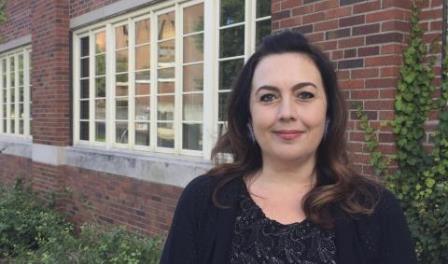
Understanding School Trauma

Katie Johnston-Goodstar and a team of youth researchers are working to understand how school climate may be negatively affecting Native American kids.
As an assistant professor in the University of Minnesota’s College of Education and Human Development’s School of Social Work, Katie Johnston-Goodstar has long studied the various factors that affect the education and development of urban and Native American youth. In particular she is interested in understanding what influences some youth to turn to violence, or maybe even join a gang. Part of the problem, she has found, starts at school. While a lot of studies focus on improving individual behaviors or how giving families more resources might help kids stay in school and increase graduation rates, Johnston-Goodstar’s research flips that approach on its head by examining how social and political factors are affecting kids, particularly native kids. “I look at how school climate may be influencing youth violence, academic success, truancy and graduation rates,” she says. One of the main questions she explores is: “How are institutions pushing native kids out?” It’s a question Johnston-Goodstar understands well. “School didn’t work for me,” she recalls, explaining how she was frequently disciplined and eventually dropped out. Native communities have historically tenuous relationships with schools and data going back to the 1920s confirms that negative school experiences for marginalized youth are not new. “Schools are assumed to be safe places for youth, but for native youth, these institutions are not neutral; this history goes all the way back to early boarding schools,” she says.
Understanding that many of today’s kids are still experiencing school trauma similar to that of nearly a century ago, Johnston-Goodstar approached the Robert J. Jones Urban Research and Outreach-Engagement Center (UROC) about helping with a community-based, youth participatory action research project called the Native Youth School Climate Study. In addition to providing research-based knowledge on issues related to youth and trauma—gleaned from UROC’s ongoing Trauma Recovery Project—the Center also provided financial support for the study along with the Minnesota Campus Compact, which supports civic engagement through a network of colleges and universities. “UROC has a long history of supporting participatory community-engaged research, and their responsiveness to projects like this is possible because they are not a traditional foundation,” she says.
At the heart of the Native Youth School Climate Study, which looks at school climate through a trauma-specific lens, is a team of 10 Native American researchers. Two are adults who work in the community in other capacities, and the rest are students from public high schools and charter schools in the Twin Cities metro area. Representing different genders, tribes and regions, the youth bring different school experiences to the project, ranging from doing well and enjoying classes, to having a lot of absences, disciplinary experiences and/or dropping out. The students, who refer to themselves as “Native Youth Researchers,” along with the two adult researchers and Johnston-Goodstar, examined multiple national surveys on school climate. “Data gathered from personal and community experience and existing literature indicate that native students experience disproportionate amounts of bullying in schools, are expelled at higher rates and experience a lot of psychological trauma at the hands of teachers and administrators but these experiences and their impacts are rarely measured,” she explains.
Research already shows that kids in schools where the climate is rated as low have higher truancy rates and other issues, but there is much more to be learned from an inclusive and indigenized definition of school climate. That’s why Johnston-Goodstar and her research team are developing a new survey that would more accurately reflect the experiences of native youth. “We’ve found that current surveys often lack questions that focus on the experience of native kids,” she explains. “So we’ve added Native-specific questions, including some that focus on experiences of racism, invisibility and tribally-specific knowledge and pedagogy”. Johnston-Goodstar is currently seeking funding for phase two of the Native Youth School Climate Study. She and some of the youth researchers would like to administer their survey and gather data on the experiences of native youth in the region. “If we’re going to change how native kids experience school climate, we have to ask the right questions and look at how schools aren’t meeting their needs or reflecting their history.”